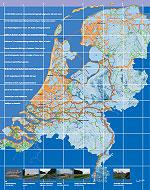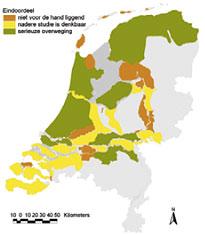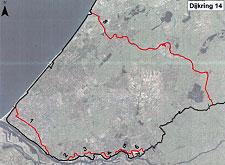Reduce flood risks by compartmentalisation dikes
Compartmentalisation is defined as the act of splitting up an object into smaller units or compartments. In terms of dike rings it means splitting up a large dike ring into (a number of) smaller dike rings.
|
Thema |
Waterveiligheid, Delta facts, English versions |
|
Tags |
|
|
Downloads |
- INTRODUCTION
- RELATED TOPICS AND DELTA FACTS
- MULTILAYER SAFETY STRATEGY
- SCHEMATIC
- TECHNICAL SPECIFICATIONS
- POSITIONING
- GOVERNANCE
- COSTS AND BENEFITS
- LESSONS LEARNED AND ON-GOING STUDY
- KNOWLEDGE GAPS
- EXPERIENCES
Introduction
status: in use
"Compartmentalisation is defined as the act of splitting up an object into smaller units or compartments. In terms of dike rings it means splitting up a large dike ring into (a number of) smaller dike rings. The primary purpose of compartmentalisation is to reduce the surface area that is inundated, primarily from the perspective that the inundated area by and large determines the flood damage and the extent of social disruption. Therefore, the objective is to minimise the flood risks by mitigating the consequences of inundation" (Asselman et al., 2008, p. b).
Compartmentalisation is an old measure, whether by design or otherwise, has long been used. Examples of compartmentalisation are provided below in this Delta Fact. Compartmentalisation is still topical because it can offer a cost-effective approach to mitigating consequential damage. Piggy-backing on infrastructural developments such as construction of roads, railways, etc., are just a few examples of how effective safety and spatial planning coordination can translate into profit.
Compartmentalisation of a storage basin system can also help in reducing the outflow rate during dike breach. This type of compartmentalisation is not discussed in this Delta Fact.
Related topics
Keywords: Cross dikes, secondary dikes, BWO barrier, category C primary flood defences
Delta Facts: Compartmentalisation in the storage basin system
Multilayer safety strategy
Multilayer safety can be categorised into three main areas:
1 Prevention, 2 Spatial Planning, 3 Crisis Management
The purpose of compartmentalisation is to reduce flood risks by mitigating the consequences (Klijn et al., 2009). Compartmentalisation dikes are therefore used as a structural measure, and as such compartmentalisation falls under spatial planning, the second layer of multilayer safety.
Schematic
The figure below is a schematic rendering of compartmentalisation:

Left: Dike breach before compartmentalisation; Right: Dike breach after compartmentalisation
Figures sourced from Kolen et al. (2007).
A compartmentalisation dike can be classified as a category C primary flood defence and or a regional flood defence. Where a compartmentalisation dike is not classified as a primary flood defence, the province or water board can classify it as a regional flood defence. Regional flood defences are subject to provincial regulations (standards for regional flood defences) and the Regulations (Keur) (Asselman et al., 2008, p. 101).
A number of common examples of compartmentalisation dikes (current and historical) are:
- The Dief dike (separation of Alblasserwaard Tieler & Culemborderwaarden)
- The Mei dike and Brakelse cross dike (Bommelerwaard)
- Cross dikes in the Beerse Meuse
- Cross dike in the Betuwe
- The Querdamm on the border with Germany between Ooij and Duffelt
- The Old Meuse dike
- The Slaper dike

- Click here to enlarge the map for a detailed view of the compartmentalisation dikes and other spatial interventions (WL | Delft Hydraulics and the Koning (2007) in Asselman et al, 2008).
In its purest form, the main function of compartmentalisation is to redirect water. (Asselman et al. 2008, p. b). However, there are many dikes and linear elements that are not used as compartmentalisation dikes but inadvertently function as such (Klijn et al., 2009). Examples of this include former primary defences (sea dikes) which, through land reclamation and calibration, are located behind dikes (so-called back dikes), railway embankments, canal embankments, noise barriers or elevated highways (Kolen et al. 2007). Examples of this are:
- highways and railway embankments (A12)
- secondary dikes (Haarlemmermeer ring canal)
- defence line dikes (Dutch Water Defence Line)

Another example is the countless inland dikes in different provinces that do not have a formal water management function.
The photo shows the structure at the intersection of the Dief dike and A2. When a flood event occurs, a barrier closes down the A2 to allow the Dief dike to carry out its compartmentalisation function.
Technical specifications
2007 saw the drafting of the green version of [1] the Directive on Standardisation of Compartmentalisation Barriers (Geerse et al., 2007). The implementation of the Directive will shed light on the positive and negative value of compartmentalisation dikes in terms of damage, casualties and fatalities for the entire dike ring. The provinces of Zeeland and South Holland are currently undertaking a standardisation process (see experiences). The function of the compartmentalisation barrier determines the situations that are ultimately considered in determining the standard.
The operation of a compartmentalisation dike is based on diverting water to prevent an entire dike ring from becoming inundated when a primary flood defence is breached.
A compartmentalisation dike may have different functions (Geerse et al. 2007, p. 1):
- Diverting the floodwaters to less vulnerable areas (in conjunction with other water retaining compartmentalisation barriers)
- Slowing down floodwaters by redirecting it to a compartment.
- Preventing inundation in a section of the dike ring area by redirecting the floodwaters.
The design of a compartmentalisation dike is no different than a regular river dike.
[1] The Directive is currently being evaluated in practice. The findings and experiences garnered during this process will serve as input for drafting the definitive blue version.
Positioning
Compartmentalisation usually leads to a smaller inundated area in the dike ring behind the breach. "The effectiveness of compartmentalisation primarily depends on the social benefits it is expected to produce in terms of avoided economic loss, fewer casualties and fewer fatalities" (Klijn et al., 2009, p. 26).
The 2008 compartmentalisation study shows the following arguments in relation to compartmentalisation (Asselman et al., 2008, p. 18-19).
| Arguments for | Arguments against |
| • Reduces the inundation area; smaller inundated area, less economic loss and fewer casualties and fatalities (Asselman, 2006). | • High costs of construction and maintenance of compartmentalisation dikes; this money could be put to better use in reinforcing the primary flood defences. |
| • Less social disruption (Ledden et al., 2007). | • Increased risk of drowning in small compartments due to the rapid rise of water. |
| • Slower breach development, as the flood cannot spread quickly. | • Allows little room for installing a second flood defence at a sufficient distance from the primary flood defence, especially in densely populated areas. |
| • Allows time for taking countermeasures; more time for evacuation and fewer victims. (Asselman, 2006). | • Impact on surrounding dike rings from adverse system operation (upper river region), whereby the water spilling through the breach into the dike ring can exit the dike ring from another location. In some cases this location borders another river (e.g. Land van Maas and Waal, where during a breach event the water can flow from the Waal into the Meuse). The spill over into the other river may increase to such an extent that it can create an above-normative situation and inundate the dike rings adjacent to this river. (Asselman, 2006). |
| • Reduces the duration of inundation, especially in tidal areas, as the breach can be closed more easily and faster. | |
| • Breach in the primary flood defence easier to close as a result of prior recovery of the compartmentalisation dike(s): smaller tidal volumes with lower flow velocities and smaller breaches. | |
| • The dikes serve as shelter for humans and animals. |
Governance
Because compartmentalisation is closely associated with evacuation during an emergency, the contact and transparency with stakeholders in an area is very important. Especially in smaller polders where water velocity can rise rapidly as the polders border the flood defence, the rate of casualties and fatalities is increased. (Asselman, 2006; Ledden et al., 2007). If a compartmentalisation barrier loses its compartmentalisation status, it may create concern among stakeholders and leave them feeling less protected.
Another aspect of governance is funding. Efforts are currently underway to evaluate the standards in WV21. Multilayer safety is funded from different government budgets. Identifying a compartmentalisation barrier could play a factor in determining who will bear the costs: the state or the region. As such, funding represents an additional barrier to the adoption of this measure, as do the laws and regulations in place, which provide that primary C flood defences fall under the Water Act, while regional flood defences are subject to a provincial regulation.
Lastly, the local government also has interests in compartmentalisation, given the impact on spatial planning.
Costs and benefits
Compartmentalisation also involves other factors such as construction or elevation of dikes, construction or adjustment of ramps and construction of culverts and cut-offs (Asselman et al., 2008). The estimated cost of compartmentalisation ranges from EUR 10 million, for elevating several kilometres of existing dikes on undeveloped land, to almost EUR 400 million for elevating or building dikes in developed areas (Asselman et al., 2008). Most surveyed routes cost between EUR 100 and 200 million. The cost per km is between EUR 2 and 15 million; EUR 2 million is estimated for the slight elevation of existing dikes, with little to no structures, and EUR 15 million for construction of new dikes/significant elevation of existing dikes with a multitude of structures and/or spatial development. In the Betuwe Tieler and Culemborgerwaarden case, the cost of elevating an existing dike is estimated at EUR 5 million per km (similar to Amsterdam-Rhine Canal), while the construction of a new dike (similar to N233 and Gorinchem) is estimated at EUR 15 million per km (Asselman et al., 2008).
The effectiveness of compartmentalisation depends primarily on the social benefits, expected to be produced (avoided economic loss, fewer affected victims, casualties and fatalities).
Criteria used for conducting an initial study on the effectiveness of compartmentalisation within dike rings were (Asselman et al., 2008, p. d):
- Dike ring surface area (large dike rings sustain more damage).
- The expected number of victims, the number of people affected and the expected economic loss.
- The properties that determine the flood gradient, such as the ground level slope and the existing compartmentalisation structures (presence of dikes, embankments and other linear obstacles).
The chances of this measure being approved depend on the required investment costs compared with dike reinforcement. These costs involved are in relation to (Asselman et al., 2008, p. d):
- Dike ring design (the length of the compartmentalisation dike in an elongated dike ring is shorter than in a circular dike ring).
- Location in relation to the source of hazard (a dike ring exposed to risk from the short side is easier to compartmentalise).
- Spatial distribution of vulnerable areas (densely developed areas are easier to barricade).
- Existing structures (elevating existing structures can be more cost-effective than building an entirely new dike).
The cost-benefit ratio of compartmentalisation dikes depends strongly on the flood probability estimate: a higher flood probability leads to higher benefits and therefore to a higher cost-benefit ratio. (Klijn et al., 2009).
Lessons learned and on-going study

As part of the compartmentalisation study of 2008, an evaluation was made of the effectiveness and probability of achieving compartmentalisation in different dike rings. In the final analysis, eight areas were identified for serious consideration. Four of these areas are included in a case study (in order of benefits):
- Betuwe, Tieler and Culemborgerwaarden
- Flevoland
- Land van Heusden/ De Maaskant
- Centraal Holland
All case studies show that construction of a well-positioned compartmentalisation dike can lead to less economic loss, lower numbers of affected individuals and a lower casualty rate (50-80%) (Klijn et al., 2009). The most attractive is the Betuwe (dike ring 43), given the higher annual benefit to cost ratio. In most other cases, the benefits are minor due to the low frequency of use of compartmentalisation barriers (ranging between 1/1.250 to 1/10.000 per year).
If victims were to be quantified in monetary terms and factored into the cost-benefit analysis (as is the case in WV21), this would raise the probability of more areas qualifying for compartmentalisation, e.g. dike ring 36 in Den Bosch, as it would translate into a positive cost-benefit analysis. Tightening the standards can have the opposite effect.
In 2007, a study was undertaken in New Orleans into dividing the city centre into compartments, thereby evaluating cost-benefit of installing low and high inland dikes (Ledden et al. 2007). But this has failed to transpire into anything concrete due to the high investment costs. The attention has instead shifted to outer ring dikes. Perhaps compartmentalisation will be put back on the agenda if serious consideration were given to raising the safety standard above 1/100 per year, which is currently the case (Ledden, personal correspondence).
Presently, a study is underway in the provinces of Zeeland and South Holland into the standardisation of compartmentalisation dikes (see experiences). In 2009, the province of Utrecht also conducted a compartmentalisation study (Ter Maat and Asselman, 2009), which found that allowing the primary flood defences to be overflowed is a good measure. The delta dike emerged as a more interesting solution in a study currently underway in the Gelderse Vallei, which aims to develop a measure for protecting Veenendaal and other major cities. The object under study is a small primary flood defence with a large area behind it. The options under consideration are compartmentalisation or reinforcement. However, due to the short length of the primary flood defence a delta dike offers a more interesting alternative.
Knowledge gaps
Further research is required to determine the usefulness of maintaining old compartmentalisation dikes. At present, construction of new dikes is the main focus of the compartmentalisation study of 2008. There is still very little information available about the effectiveness/necessity of existing flood protection elements, breach development and impact of inflow. Understanding of breach development is important for determining the volume of water that flows in after a dike breach, and therefore the water level against the compartmentalisation dike. Although assumptions are currently being made about breach development, they need to be substantiated by observations. One topic of discussion that is still on-going is how high and strong compartmentalisation dikes should be. There is no data available about the subsoil and profile of the dikes. DINOdata from TNO are not yet sufficient to fill the knowledge gap. Another element is researching the effectiveness of compartmentalisation in the face of severe climate change and sea level rise (more extreme consequences -> greater benefits).
A possible alternative to compartmentalisation would be to adopt differentiated standards for each dike section instead of a uniform standard for the entire dike ring. This is being further investigated for the category C flood defence in the Channelised Hollandse IJssel (Vat et al., 2011). Primary flood defences are standardised at 1/2000 and compartmentalisation dike at 1/10.000. To ensure the required level of protection, an option would be to standardise a section of the dike along the Lek at 1/10.000. The legal aspects in relation to differentiation within a dike ring need to be further investigated.
Experiences
Province of Zeeland
Interview of 22 June 2011 with Ms Y. Peddemors of Zeeland, additions in August 2012.
The executive board programme of the Province of Zeeland sets out an ambition to deliver an assessment about all regional dikes in Zeeland before 2011. This assessment addresses whether or not a regional flood defence should be identified and the adoption of a particular standard, where the standard is expressed in terms of height and stability. To that end, the project "Standardisation of Regional Flood Defences" was launched in autumn 2008. The project group consists of employees of the Province of Zeeland, Scheldestromen water board and Zeeland Department of Waterways and Public Works. The project studies compartmentalisation in terms of redirecting, slowing down or diverting floodwaters. The results of this project will serve as successor to the guideline of 1994.
In 2009/2010, an inventory-based study was conducted into regional flood defences. Part of the inventory concerned classifying flood defences, such as intersecting dikes and erectable dikes that were still classified as regional, into primary flood defences. The function ‘escape and transport routes’ on regional flood defences was also examined. Subsequently, in late 2010, the locations of the regional flood defences in the province of Zeeland were identified, where approximately 95% of compartmentalised embankment dikes were located on dry land with the objective of diverting floodwaters away from the city centre in the event of a flood event. On 25 January 2011, a revised official registration of the dikes took place by the Provincial Executive. This means that, pursuant to the GS Decree of 25 January 2011, the changes at 26 locations will be implemented within the Regulations of the Water Board in 2011. A number of dikes have lost their status, especially highly compartmentalised areas, in order to prevent a 'bathtub' effect in very small areas where water rises rapidly. As yet, however, no agreements have been reached on how to deal with the 'unidentified' bodies.
During the review of the system in 1994, the following changes were suggested:
- Primary -> regional
- Regional -> primary
- Regional -> no status
- No status -> regional
In the latter case, residents are unexpectedly faced with the Regulations. This requires clear communication.
Possible adjustments include:
- Adjusting the standard to the current level; allowing regional flood defence to be overflowed (slowing down)
- Elevation (redirecting)
- Deliberate lowering; increasing the stability certainty can be achieved by lowering and allowing the local water defences to be overflowed. This also increases the predictability of the flood pattern that occurs when the primary flood defence breaches (diversion).
Work should preferably be aligned by linking solutions to area development and area plans of municipalities.
In 2012, the province of Zeeland conducted an analysis based on existing calculations to determine which locations would require further calculations to adjust the height of the compartmentalisation barriers in the model in order to study the impact this would have, in particular in the area of damage and victims. These additional calculations will hopefully be performed in the summertime, after which the project group (including the water boards and the regional Department of Waterways and Public Works) will submit a proposal for height and stability standards. The aim is to establish these standards in 2013.
Additionally, the province of Zeeland will make every effort to keep this topic from becoming isolated and will integrate it within MLV, VNK, regional flood defences and the new standards (of primary flood defences).
Province of South Holland
Interview of 22 June 2011 with Ms S. Fraikin and Mr P.J. Hofman of the province of South Holland
Following on the standardisation of secondary dikes in 2006, the "Provincial Water Plan of South Holland 2010-2015" provides that compartmentalisation barriers will be standardised in 2011.

Thus, in early 2010, the province of South Holland launched a study to identify and possibly standardise compartmentalisation barriers in consultation with the water boards concerned. The first phase of the study assesses the effectiveness and necessity of the selected, existing compartmentalisation barriers, where the following eight compartmentalisation barriers, for example, were assessed for dike ring 14:
1) Meuse dike, 2) Maassluis dike, 3) Vlaardinger dike, 4) Mathenesser dike, 5) Blaak, 6) Abram van Rijckevorselweg, 7) A16 and the 8) Rhine dike.
Six steps will be carried out within the process to develop standards for compartmentalisation barriers, namely:
- Define system and function of compartmentalisation barriers.
- Determine flood scenarios; without compartmentalisation dike, current condition of the compartmentalisation dike or infinitely high compartmentalisation dike.
- Determine design alternatives.
- Test for safety.
- Cost-benefit analysis.
- Uncertainty analysis.
Subsequently, three parameters will be tested for each compartmentalisation dike: impact of the barrier on flood pattern, possible effective design alternatives and the feasibility of dike adjustment. At this point, it is assumed that the selected compartmentalisation dikes will not be breached (stability is guaranteed).
The computational results are expected to be released in autumn 2011.
Subsequently, after establishing the effectiveness and necessity of each barrier and verifying the feasibility of improvements through a cost-benefit analysis, the process will shift to the second phase, which involves determining whether there is administrative support for standardisation of the compartmentalisation barriers. A public discussion will then be held about the results of the study.
In addition, the province of South Holland will incorporate compartmentalisation in the zoning plans for consideration by MARE, the European Centre for Maritime Research.
Province of Utrecht
Email correspondence with Mr P. Beerling of the province of Utrecht on 8 July 2011, with follow-up in August 2012.
The province of Utrecht has one compartmentalisation dike, the Slaper dike. This compartmentalisation dike (in Veenendaal and surrounding areas) is located in the management area of the Vallei en Eem water board and bisects the Gelderse Vallei.
The Slaper dike slows down the flow of floodwater to Amersfoort after a dike breach and offers the city of Amersfoort and surrounding areas more time to evacuate. The Vallei en Eem Flood Defence Bylaw provides that the Slaper dike may only be used when Veenendaal has been evacuated. The dike is standardised in the bylaw and is transposed into the Vallei en Eem Water Board Bylaw. The bylaw stipulates that all cut-offs in the Slaper dike must be made lockable. The dike is subject to the following safety standard: retains current profile.
The province of Utrecht is currently highly involved in the debate about compartmentalisation barriers, including the future of the C flood defences along Channelised Hollandsche IJssel and Amsterdam-Rhine Canal.

 English resume
English resume